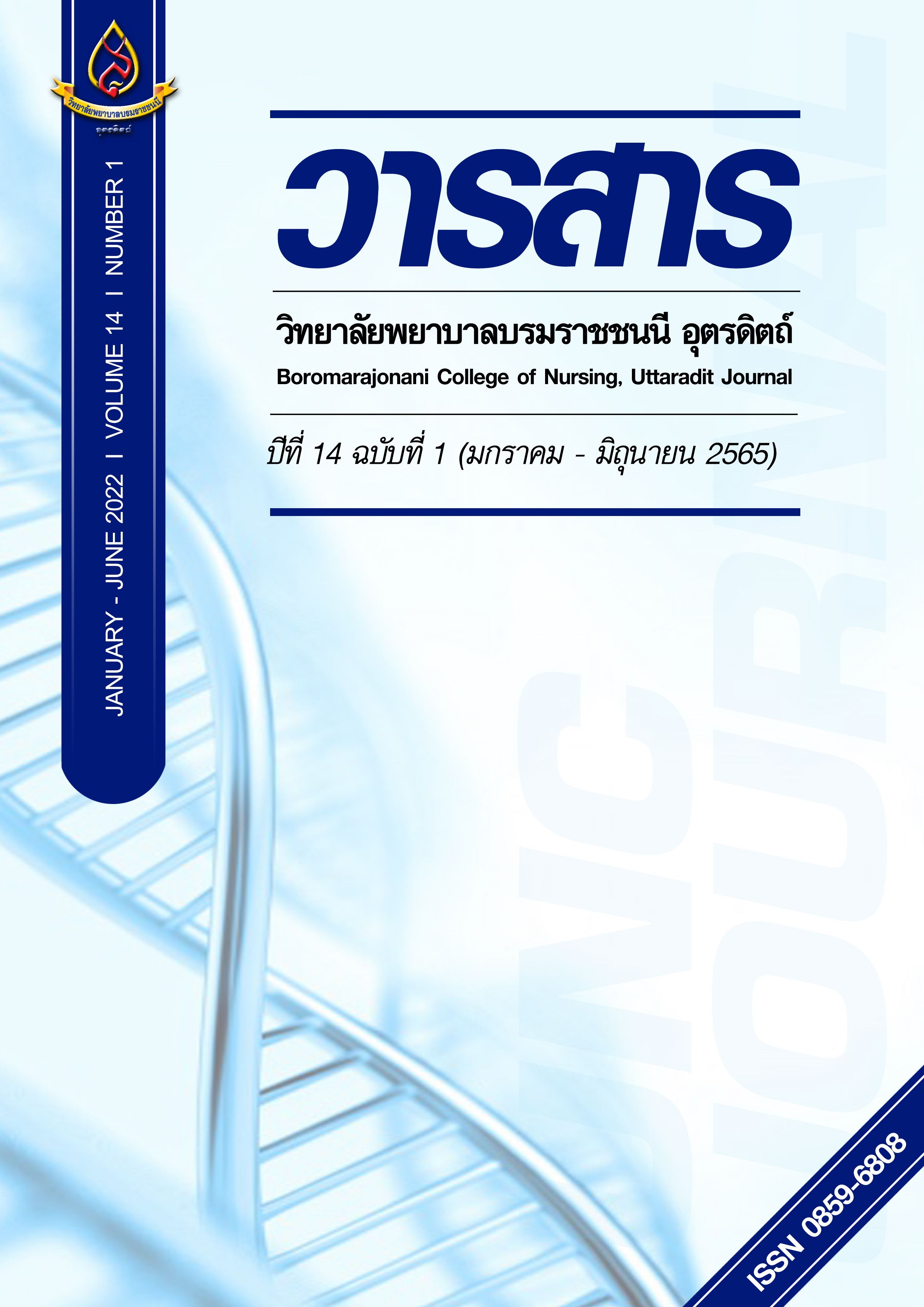การวิเคราะห์แนวคิดความไว้วางใจให้ปฏิบัติการพยาบาล
Main Article Content
บทคัดย่อ
การวิเคราะห์แนวคิดความไว้วางใจให้ปฏิบัติการพยาบาล (entrustable professional activities in nursing: EPAs) บทความนี้มีวัตถุประสงค์เพื่ออธิบายความหมาย องค์ประกอบและระดับของ EPAs โดยการทบทวนวรรณกรรมที่เกี่ยวข้อง พบว่า EPAs หมายถึง งาน กิจกรรมหรือความรับผิดชอบที่มอบหมายให้ผู้ปฏิบัติที่มีสมรรถนะเพียงพอด้วยความไว้วางใจให้ปฏิบัติได้ และสามารถปฏิบัติได้โดยลำพังหรือปราศจากผู้นิเทศ EPAs มีองค์ประกอบ 3 อย่างคือ 1) การจำกัดด้วยจำนวนงานที่รับผิดชอบ 2) การสะท้อนถึงประสบการณ์ที่เพิ่มขึ้น และ 3) การยอมรับได้และวัดประเมินได้ EPAs มี 5 ระดับคือ ระดับ 1 ยังไม่สามารถปฏิบัติกิจกรรมเองทั้งหมดได้ ระดับ 2 สามารถปฏิบัติกิจกรรมได้ภายใต้การนิเทศทั้งหมด ระดับ 3 สามารถปฏิบัติกิจกรรมได้ภายใต้การนิเทศห่าง ๆ ระดับ 4 สามารถปฏิบัติกิจกรรมได้ตามลำพังหรือโดยอิสระ และระดับ 5 สามารถปฏิบัติกิจกรรมได้ตามลำพังหรือโดยอิสระและสามารถนิเทศผู้อื่นได้ องค์ประกอบและระดับของ EPAs สามารถนำไปประยุกต์ใช้ในการปฏิบัติการพยาบาล ใช้เป็นแนวทางในการมอบหมายงานและการประเมินความสามารถของพยาบาลวิชาชีพในการปฏิบัติการพยาบาล โดยเฉพาะในพยาบาลวิชาชีพที่สำเร็จการศึกษาใหม่
Article Details

อนุญาตภายใต้เงื่อนไข Creative Commons Attribution-NonCommercial-NoDerivatives 4.0 International License.
บทความหรือข้อคิดเห็นใดใดที่ปรากฏในวารสารวิจัยการพยาบาลและวิทยาศาสตร์สุขภาพ เป็นวรรณกรรมของผู้เขียน ซึ่งบรรณาธิการหรือสมาคมศิษย์เก่า ไม่จำเป็นต้องเห็นด้วย และบทความที่ได้รับการตีพิมพ์เผยแพร่ถือเป็นลิขสิทธิ์ของวารสารวิจัยการพยาบาลและวิทยาศาสตร์สุขภาพ
เอกสารอ้างอิง
Al-Moteri, M. (2020). Entrustable professional activities in nursing: a concept analysis. International Journal of Nursing Sciences, 7(3), 277-284.
Chen, H.C., McNamara, M., Teherani, A., Ten Cate, O., & O’Sullivan, P. (2016). Developing entrustable professional activities for entry into clerkship. Academic Medicine, 91(2), 247-255.
Dhaliwal, U., Gupta, P., & Singh, T. (2015). Entrustable professional activities: teaching and assessing clinical competence. Indian Pediatrics, 52(7), 591-597.
El-Haddad, C., Damodaran, A., McNeil, H.P., & Hu, W. (2016). The ABCs of entrustable professional activities: an overview of entrustable professional activities’in medical education. International Medicine Journal, 46(9), 1006-1010.
Englander, R., Flynn, T., Call, S., Carraccio, C., Cleary, L., Fulton, T.B., Garrity, M.J., Lieberman, S.A., Lindeman, B., Lypson, M.L., & Minter, R.M. (2016). Toward defining the foundation of the MD degree: core entrustable professional activities for entering residency. Academic Medicine, 91(10), 1352-1358.
Franklin, N., & Melville, P. (2015). Competency assessment tools: an exploration of the pedagogical issues facing competency assessment for nurses in the clinical environment. Collegian, 22(1), 25-31.
Fukada, M. (2018). Nursing competency: definition, structure and development. Yonago Acta Medica, 61(1), 1-7.
Hart, D., Franzen, D., Beeson, M., Bhat, R., Kulkarni, M., Thibodeau, L., Weizberg, M., & Promes, S. (2019). Integration of entrustable professional activities with the milestones for emergency medicine residents. Western Journal Emergency Medicine, 20(1), 35.
Holzhausen, Y., Maaz, A., Renz, A., Bosch, J., & Peters, H. (2018). How to define core entrustable professional activities for entry into residency? BMC Medical Education, 18(1), 87.
Merriam-Webster (2017). Merriam-webster dictionary. Retrieved from, https://www.merriam-webster.com.
Meyer, E.G., Chen, H.C., Uijtdehaage, S., Durning, S.J., & Maggio, L.A. (2019). Scoping review of entrustable professional activities in undergraduate medical education. Academic Medicine, 94(7), 1040-1049.
Nonsee, P., Pornsumritchok, J., Wattanakul, S., Yotsurin, P., & Tancharoen, P. (2020). Effects of teaching by using role -play in case scenario on knowledge practice and attitude of shift report with SBAR technique: in 4Th year nursing student of BCNC. Boromarajonani College of Nursing, Uttaradit Journal, 12(2), 26-39. (in Thai).
Nursing Council. (2021). Bachelor of nursing science program: the nursing council’s model program 2021. Nonthaburi: Nursing Council. (in Thai).
Nursing Council. (2018). Nursing council announcement on the core competencies of graduates with a bachelor's degree. Nonthaburi: Nursing Council. (in Thai).
Pangaro, L., & Ten Cate, O. (2013). Frameworks for learner assessment in medicine: AMEE Guide No. 78. Medical Teacher, 35(6), 1197-1210.
Surjadi, M., Stringari, M.S., & Saxe, J.M. (2019). Entrustable professional activities in nurse practitioner education. Journal for Nurse Practitioner, 15(5), 97-102.
Ten Cate, O., & Young, J.Q. (2012). The patient handover as an entrustable professional activity: adding meaning in teaching and practice. BMJ Quality & Safety, 21(Suppl 1), i9-12.
Ten Cate, O. (2005). Entrustability of professional activities and competency-bases training. Medical Education, 39(12), 1176-1177.
Ten Cate, O. (2016). Entrustment as assessment: recognizing the ability, the right, and the duty to act. Journal of Graduate Medical Education, 8(2), 261-262.
Ten Cate, O. (2013). Nuts and bolts of entrustable professional activities. Journal of Graduate Medical Education, 5(1), 157-158.
Touchie, C., & Boucher, A. (2016). Entrustable professional activities for the transition from medical school to residency. Ottawa, Ontario, Canada: Association of Faculties of Medicine of Canada.
Van Loon, K.A., Driessen, E.W., Teunissen, P.W., & Scheele, F. (2014). Experiences with EPAs, potential benefits and pitfalls. Medical Teacher, 36(8), 698-702.
Wagner, L.M., Dolansky, M.A., & Englander, R. (2018). Entrustable professional activities for quality and patient safety. Nursing Outlook, 66(3), 237-243.
Warm, E.J., Mathis, B.R., Held, J.D., Pai, S., Tolentino, J., Ashbrook, L., Lee, C.K., Lee, D., Wood, S., Fichtenbaum, C.J., & Schauer, D. (2014). Entrustment and mapping of observable practice activities for resident assessment.Journal of General International Medicine, 29(8), 1177-1182.


